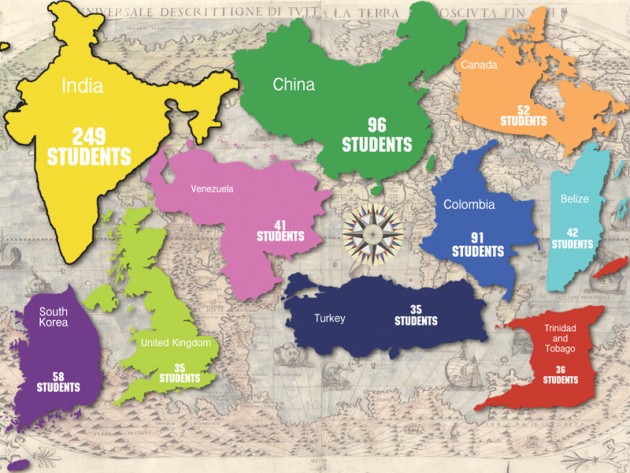Increased international interest

More of USF’s international students hail from non-European countries today than in the past, study abroad administrators said. And as USF tries to market its international-student program to scholars around the globe, partnerships with other universities might bring students from even more countries.
Of the 1,345 international students, 249 are from India. This is more than twice as many as the second most popular country, China, with 96 students.
Director of International Service and International Affairs Marcia Taylor attributes this to the University’s agreements with institutions in India.
“(What) we’ve found is that there has also been word of mouth from current students telling their friends and family back home that USF is a good place to come,” she said.
USF’s study abroad program is seeing increased interest from countries around the globe, too.
“We have a new (exchange) agreement with Turkey this year, and got two students from that. It’s our first partnership with a Turkish university,” said Patricia Smith, program coordinator of Education Abroad. “Altogether, we have 95 international-based exchange students this semester.”
Jim Pulos, assistant director of Education Abroad, said interest is branching beyond traditionally popular Western European countries into Africa, Asia, the Middle East, Central America and South America.
USF is interested in building its international population and is aided by Education USA, a worldwide program that provides international students with information about U.S. universities, said Patricia Grossman, assistant director of undergraduate admissions.
“If I am a prospective student in China, I can go to the Education USA in Beijing and say, ‘I’m interested in going to the U.S. to study, can you help me?'” she said. “They will have information on not just USF, but information on how to apply to many institutions.”
International campaigning for USF is done through organizations like Education USA and the Internet.
“Part of the issue is that we don’t have a budget to really recruit — for me to pick up and go traveling around the world,” Grossman said. “Our whole admissions Web page is going to have a new look. We are really working hard on the international one, to make it easier for them to understand how to apply. Also, we have increased our international team.”
USF’s exchange and study abroad programs are promoted in many ways, including the Web site and fliers, Pulos said.
“I’ve visited some of our exchange partners and have had a chance to speak with students there to conduct some small orientation and information sessions,” he said. “That happens infrequently, though.”
Despite the push for recruitment, the University is sticking hard to its English-language requirement for international students.
“We have a requirement that they must have a proficiency of the English language in order to come,” Smith said. “We want them to do well and get good reports back on their transcript for their home university.”
This wasn’t a concern for Angie Magill, a junior exchange student from Australia and electrical engineering major. She picked America because it’s an English speaking county.
“My university has a list of the universities with which they have an exchange agreement. USF was one of those. I was definitely interested in coming to America,” she said. “I used to see much of American culture in Australia, but I wanted to see what America was really like.”
Other exchange students said they came to USF because of its big campus.
“It is a huge campus compared to my home university’s campus. There are a lot of prestigious professors here, which I like a lot,” said Miguel Rodriguez, a junior exchange student from Colombia and computer science major. “I like all of the social events, like Homecoming Week. We don’t have that kind of stuff. The social stuff is what I’ve liked the most about here.”







